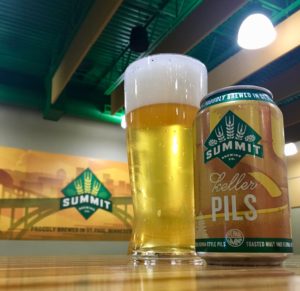Thank Chemistry For Keller Pils
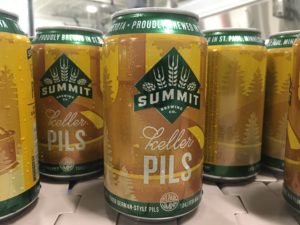
Summit Keller Pils has made its triumphant return as a bona-fide summer staple. This isn’t by accident, of course. It’s because we have a freaking chemist working in our Quality Assurance department.
With a degree in Biology, five years’ experience as a production scientist, and two years under his belt with Summit Brewing Co.’s quality team, Chemist Zach Quandt has played an important role in ensuring Summit Keller Pils looks, smells, and tastes just how it’s supposed to: Awesome.
Let’s start with how it looks
“We have a haze benchmark for Keller Pils,” Quandt says. “It shouldn’t be opaque, but we don’t want it polish filtered to near brilliance like Summit EPA. We want an old-style unfiltered German beer like those pulled directly from the fermenter.”
“There’s a grading scale for haze,” he explains. “This is more exact than looking at a beer and saying ‘Wow, that’s pretty effing hazy.’ In fact, we use the European Brewers Convention haze scale.”
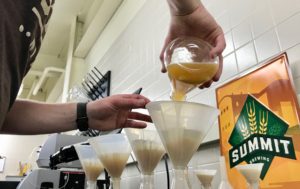
A traditional kellerbier like Keller Pils gets its slightly hazy appearance not from suspended yeast but from proteins and polyphenols. To keep these compounds from disappearing, Keller Pils needs to chill after fermentation. And we’re talking cold-cold temperatures, like almost-zero-degrees-for-at-least-28-days cold. This, by the way, is where kellerbiers get their name: Keller ––> German for cellar ––> Basements are pretty cold.
BONUS KNOWLEDGE: Kellerbiers are also known as ‘zwickelbiers.’ A zwickel is a valve that attaches to the side of a fermentation tank, allowing beer to be poured directly from the tank into your glass, and then into your mouth. Basically, a zwickel is your best friend.
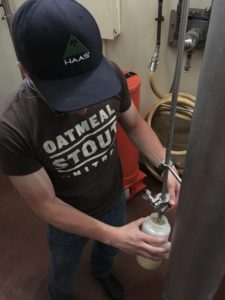
Aromas and Flavors Created by Natural Carbonation
Quandt is also responsible for monitoring carbonation during fermentation. Keeping a close eye on carbonation during this stage, and throughout Keller Pils’ brewing process, is crucially important because unlike the majority of brewers, Quandt says, “the bulk of our carbonation comes from bunging [sealing the tank] and natural carbonation. Summit relies on it.”
As you beer geeks know, yeast eats sugar and produces alcohol and CO2 during fermentation. Because our fermentation tanks are sealed and rated for pressure, all of that CO2 is retained and forced into the liquid beer, rather than being blown off.
“It’s a traditional process with high-tech equipment,” Quandt says, “and this makes our tanks very rare and very expensive. They need to have excess headspace, too.”
Fermentation, you see, produces a lot of gas and foam, and these things take up space. In order to fill that space with even more beer, most brewers blow off all that CO2 and foam, not to mention unique flavors and aromas they’ll never get back — no matter how much CO2 they pump back into the final beer.
At Summit, however, we fill our fermentation tanks to 75 percent capacity and leave the rest of the space for foam and CO2. Leaving this much space is expensive, as we could be brewing even more beer via forced-carbonation methods. But damn it, we don’t want Keller Pils to lose its honey undertones, floral notes, or its pretty foam head. So, we choose quality over quantity. Just like you do.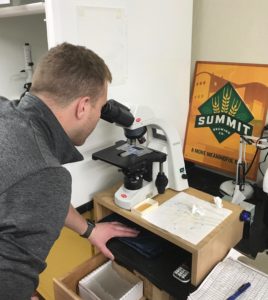
Foam Sweet Foam
Quandt’s boss, Director of Quality Rebecca Newman, often says, “Foam is like an elastic waistband. Once you stretch it too much, it doesn’t come back.”
The extra space in our tanks allows us to retain the foam in Keller Pils, treat it well, and avoid beating it up. We give it compliments and build up its self-esteem, too — you know, standard motivational poster material like, “Be the foam you want to see in the world,” and “Do more of what makes you foamy.”
As a result, Keller Pils — along with all other Summit beers — pours a nice consistent foam with small, tight bubbles. That foam sticks around, too, creating rings in the glass that look all trippy and artsy on Instagram.
“When we pour a beer,” Quandt says, “it’s really the first time the foam is being transferred out of the protective environment.” Similarly, it’s also the first time the beer’s flavors and aromas have had the chance to escape. So, when you pop open that can of Keller Pils and pour it slowly into a glass, you can be certain your beer has reached you looking, smelling, and tasting just how we intended — as if it came right out of the zwickel in our fermentation cellar.
